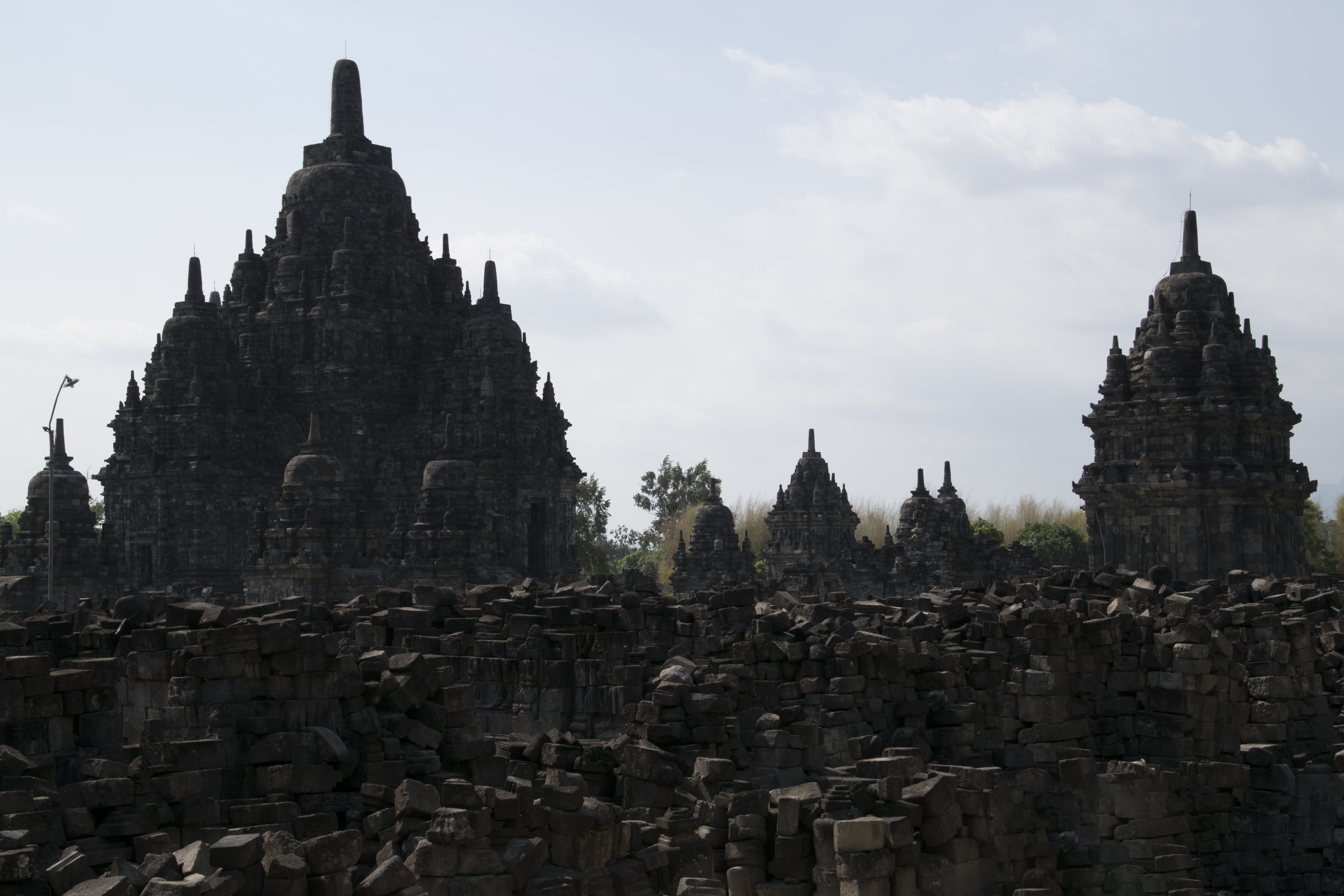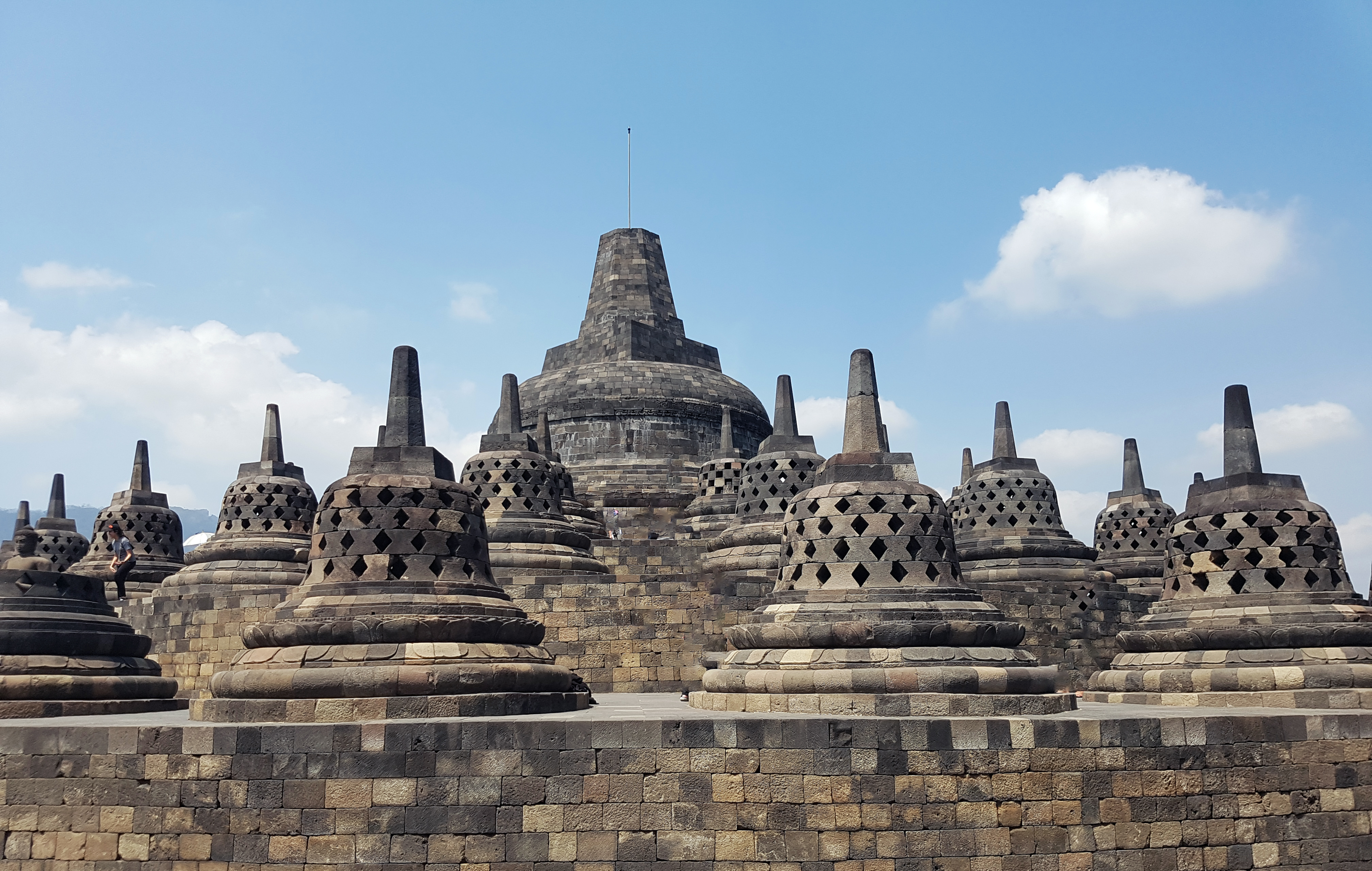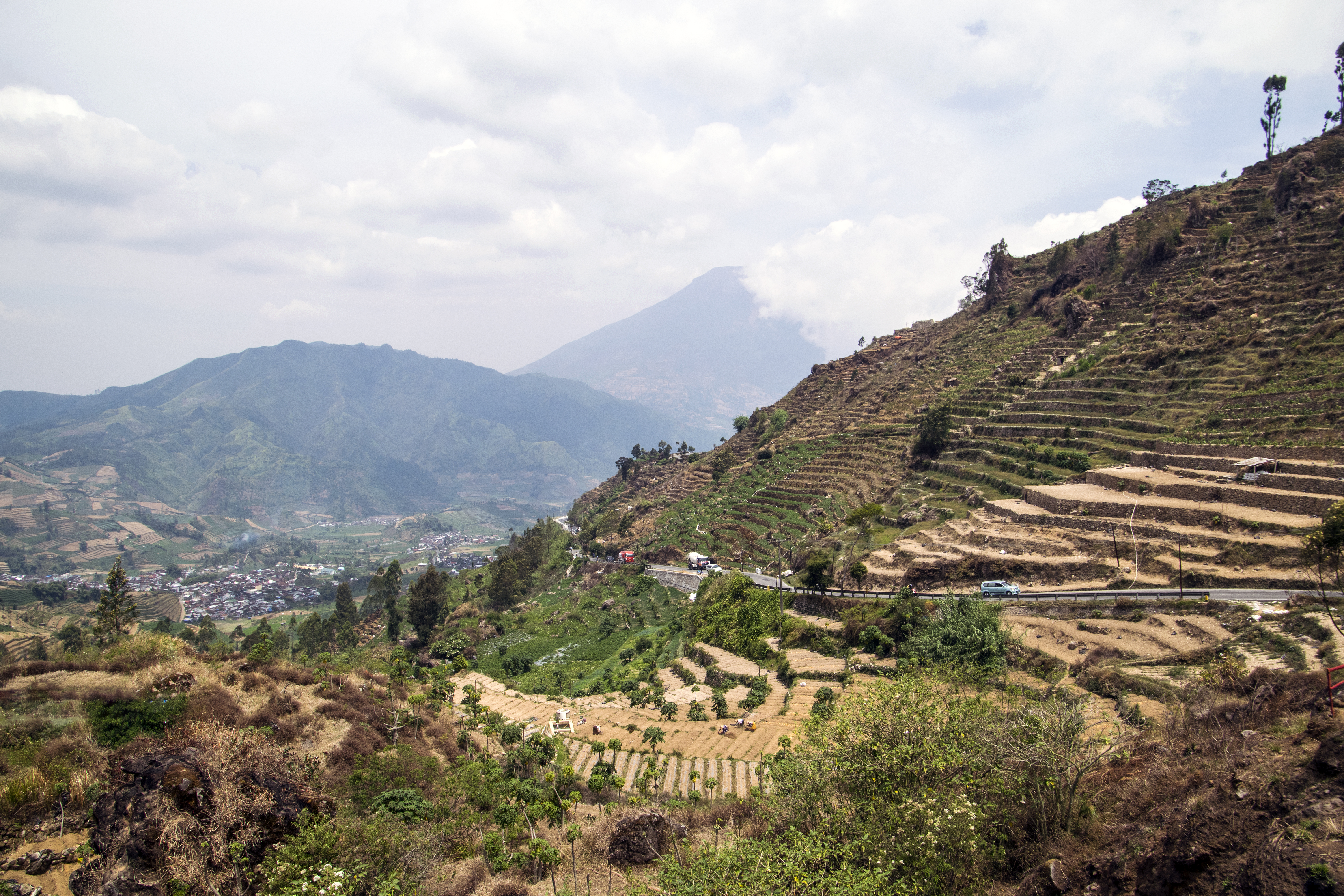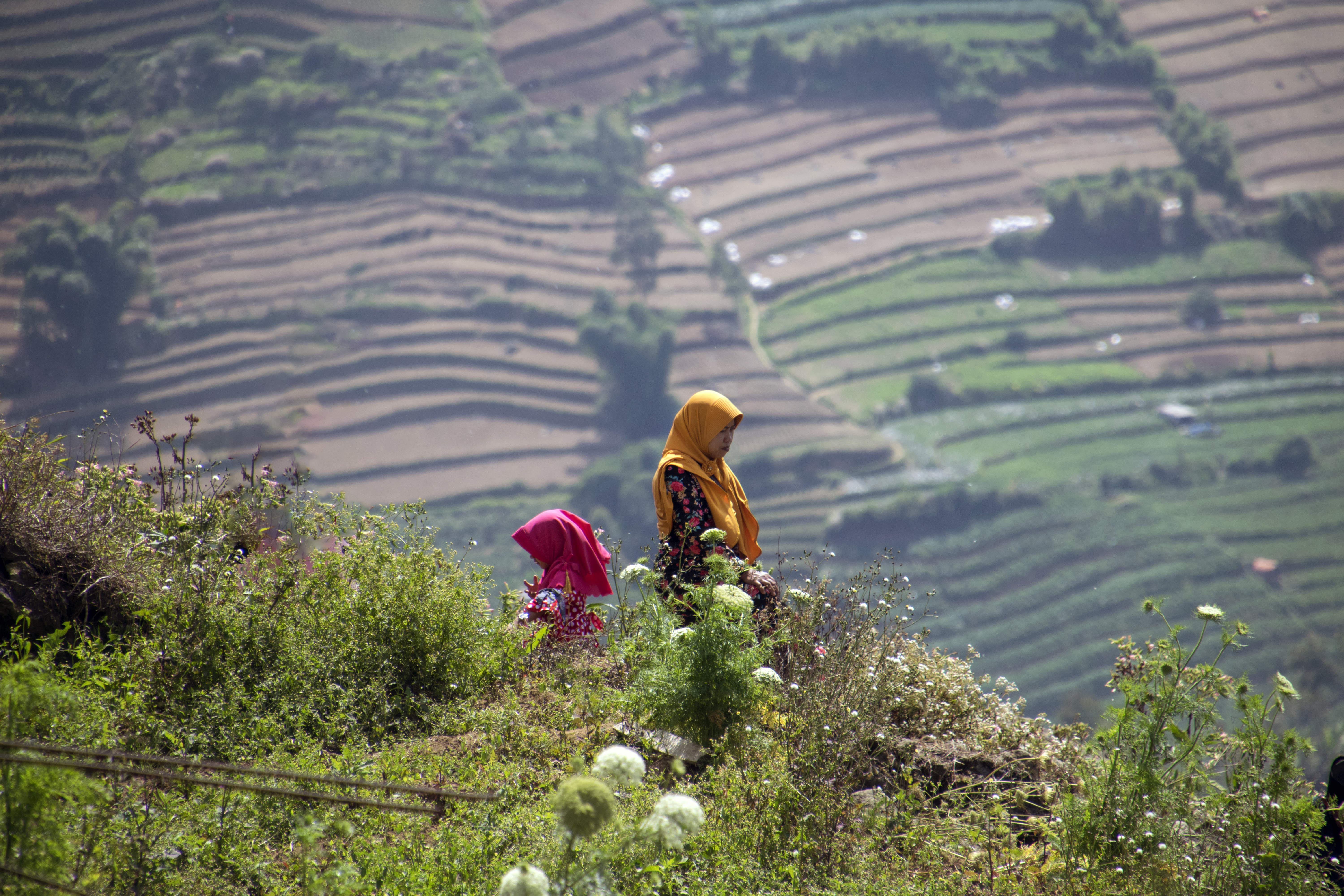
| Start | Familie en Vrienden | Sport | Racketlon | Jongleren | Reizen | Digi foto's |
| Inleiding | Wetenswaardigheden | MaleisiŽ | Java | Bali | Video's | Foto's |

 Foto: 'Prambanan' |
Sunday 7th October: with little delay and despite our maps app we arrived at the airport of Penang. Via Singapore we flew to Jogjakarta, Java Indonesia. We already booked a hotel, close by the airport, and slept in a beautiful room where not all was as it seemed, for the ceiling creaked with loud creaks, almost as if above there was a wooden floor up there, like ours below. Still we ordered food to the room and slept. Monday 8th October: today we went to Wonosobo. Yesterday evening Kirsten mailed two Dutch companies operating in Indonesia. One of them replied within a hour that they had a private driver for us. The price was similar to another we got so we went with it. The next morning we met Roy, who drove us to Dieng plateau. His English wasn?t that well, but with help of google translate on his phone communication actually went smooth. It was a 3.5h trip, of which the first two hours were surrounded by little houses/villages. Then we entered some more open areas with rice fields all over. Kirsten picked a lunch spot there, and some people wanted to have a photo with us. The lunch itself, ayam nasi chili (chicken rice spicy) and ayam mie (chicken noodles) was good and around 3.30 we arrived in one of the best booking.com hotels in Wonosobo. Two stars, ?23 a room, one little window high in the wall, but with a nice pub with balcony. Here we relaxed and later we had diner close spending ?5 (ayam nasi, ayam mie, baked bananas with chocolate, two hot tea since cold drinks here were either weird or uncanned). Like in Malaisia, a knife is considered to be a weapon, so for eating you usually don?t get one and have to make do with spoon and fork. Some meals are better prepared for this than others, but we found the side of a spoon works quite well. |
|
Tuesday 9th October: Our breakfast had chocolate sprinkles!! Unfortunately that was the only positive thing about it. Roy picked us up and we drove to the Dieng plateau. Every meter of roadside is covered with some dwelling or business, whether we are in a city or not. At some point we see agriculture on terraces in-between, which is the scenery as we climbed to ~2000m. At the picture point however it appeared we were the more interesting scenery, and while Bas was smiling at countless camera phones, Kirsten managed to escape and found a quiet spot without power cables to spoil the pictures. The plateau is actually the caldera of an ancient volcano, and every square meter of it that isn?t rock, is someone?s farm. This (once) desolate place could only be lived in by Gods, and Dieng means ?habitat of the Gods?. In ancient times, say ~800AC engineers created waterworks to drain the swampy caldera and in time 400 temples (mostly Hindu dedicated to Shiva, the god of creation and destruction). Though nicely laid out, to us the temples were not that interesting, however the environment around it was a nice experience: in one place there was a large pit of boiling mud, which explained why everyone was trying to sell us mouth caps. None in the long line of shops managed to guess our nationality and we safely reached yet another caldera in the caldera, with two large lakes in it. In its center, the newformed dome had collapsed ages ago and a few grotto?s had formed. Ancient wisdoms were signposted here. It appeared that one particularly dark cave worked miracles for women that had trouble getting pregnant, and there were smiles upon reading that.
Foto: Prambanan |
 |

|
We walked around the first lake and found that at places its shore was littered with old motorcycle engines powering water pumps. Dozens of them in one place being tended by a couple of men. We followed the piping out of the caldera and found that the lakes were the source of all the irrigation we?d seen going on on the plateau. On the way back we had lunch with a great view of the valley and continued our way to Borobudur, where we stay in a lovely little hotel. Every room is half of a small house with its own moat filled with water and colorful fish to guard the place. The backdoor leads to the largest bathroom ever, half open to the skies. Professionally, Kirsten was taught that mosquito?s carrying Dengue fever are around all day. We have been most fortunate to have seen almost no mosquitos to date, and in fact only used DEET on the first night in Malaysia.
Wednesday 10th October: part of breakfast was mystery again. We walked the 800m to one of the highlights of the holiday: Borobudur. It's the biggest Buddhist sanctuary of the world and the most popular tourist attraction of Java. Is was build between 750 and 825. Around 55.000m3 stones were custom made and transported to the construction site. After several volcano eruptions the region was covered by a thick layer of ash and abandoned. The temple was overgrown by jungle. During an inspection tour in 1814 the British governor Raffles heard stories from the local population about a big monument in the forest. He sent the Dutch engineer Cornelius for research. With the help of 200 men he removed in two months a layer of ground and the monument emerged. The first restoration started in 1907-1911. The temple had been build on a square base of 123 by 123 meter. It?s shape ?mandala? represents the cosmos: the base being the world and the top the heaven, Nirvana. Climbing the temple is a spiritual step on the way to enlightenment. |
|
The temple consists of six square terraces, diminishing in size as they go up, among others displaying the life of Buddha in the reliefs on the walls. The uppermost three terraces are circular, and contain 72 mini stupas (bell shaped, with a Buddha statue inside) encircling a single large stupa in the center. Touching the Buddha?s means good fortune to you, so fortunately the bells are erected in stone mesh, so you can reach inside. Like with all Buddhism sanctuaries you have walk clockwise (we?re sure most of the readers of this story didn?t know this). Oops. Oh wait, we did! Borobodur goes up a bit, so it provides a great view of the plains and mountains beyond. Borobudur is a place for pilgrimage and is listed on the UNESCO since 1991. On the way out we had to ?. find the way out. There was a maze with hundreds of meters of shops shops and shops. Luckily the exit was signposted. We had a great laugh when we saw an exit-sign being moved, realizing it was just to control the flow of people into and through the maze. We walked some more, but then we got out. We visited a lovely single Stupa on the way to a traditional Javanese restaurant. We again smiled when we noticed that the only type of car on the lot was Toyota Avanta, which meant that each guest had booked a private tour. Still it was the best meal yet, and in a lovely setting. Most tourists here, by the way are Asian, it?s good to keep that in mind. Bas could just handle the spicyness of his delicious tofu-soup, and Kirsten had among others a lovely dry crispy mie/egg thing. Now that would be a great recipe to possess. Back on the road, Roy bought us some strange fruit he wanted us to try. (We were driving through fields with the stuff, but we forgot the name). It takes some effort to open it, but then it has a modestly sweet pineapple-like taste. We also learned that license plates starting with ?AB? are from Jogjakarta, and Kirsten stopped stepping into random white cars thus plated. |
 |
 |
The next stop was the other highlight of Java: the temples of Prambanan: the biggest Hindu temple complex of Java. The temples were build around 850. Again volcanic mayhem caused the temple site to be damaged and vacated and the area was hidden for several centuries. Roy reminded us that in 2010 all area within 20km of the nearby Merapi was evacuated, as it spilled lava and belched up great boulders. He showed us one of these next to the road and near a river that had since been swepped downstream during a flood. After 4 years Merapi became more quiet and after another 4 it ceased to be active. In 1811 Prambanan?s ruins were found and in 1991 it became part of the UNESCO world heritage list. Restoration is ever ongoing. We walked for two hours to visit two smaller temple complexes, one of them perfectly described our idea of a ?tuinhuisje? (little house in the garden) sales area. ?As you see when can build them in series, or would you rather have a larger size?? The third one was very impressive though mostly still rubble under restoration. The biggest, Prambadam itself, we left for last. And this is where almost all visitors were gathered. The earthquake of 2006 caused lots of damage, so we saw quite some restoration sites during our visit. On the way out we again navigated a few miles of tourist stalls. Last stop was our hotel, which turned out to be nice and cozy. About 10 rooms, a swimming pool with the proportions of our future tuinhuisje (although we now came to the conclusion that we might have to measure it more precise at home, since we may have to change it) and a lovely little garden and restaurant. In the hotel room we made a test on the latest signposts and traffic rules introduced in the Netherlands. It started with ?Do you think you will pass the test?? (16/20 needed). Bas answered ?Yes, most certainly?, Kirsten answered ?Oh, I really don?t know, probably not?. Results: 12/20 for Bas, 14/20 for Kirsten. |
|
Thursday 11th October: today we saw the young city Yogyakarta, which has been build around the Kraton Palace (1755). The city has a population of 600.000 people, with lots of students. We visited the Taman Sari which was build by Sultan Hamengekubuwono I in 1758. Later this Taman Sari, water palace, was used as pleasure garden for the royal family. The part of the complex which was repaired had three baths, two for women and one for men, separated by a tower with windows on either site. Upstairs the Sultan could guard his harem and select his lady for the night. ? We found the entrance to the underground mosque and discovered that the area is riddled with underground passages. One of which led to a beautiful round construction, which could only be entered underground, but then went up a couple of steps to the surface. Next stop was the Kraton palace, the extensive complex of the Sultans of the city. The palace resembles the Hindu-Javanese cosmology (obviously) and part is open to visitors, the rest is still reserved for the royal familiy. Among others you see the classic royal gamelan instruments (we?re not sure what gamelan means, but they looked loud), the royal meeting hall, some personal belongings of the Sultan in a museum, two Dutch certificates and several gifts from all over the world, received by the royal family. Not really very interested in the royal family?s history we liked the water palace better. The afternoon Bas spend reading without interruptions in a big lobby of an inner city hotel, while Kirsten went shopping.
Friday 12th October: reading day and rice dinner + wine. The Balinese wine costed as much as the food, but still cheap for Dutch standards. Foto: voormalig koninklijk badhuis te Yogyakarta |

|